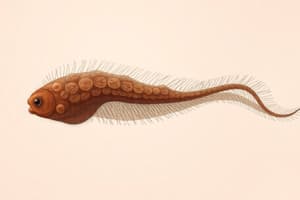Podcast
Questions and Answers
What is the phylum of the liver fluke?
What is the phylum of the liver fluke?
Porifera
What is the genus of the liver fluke?
What is the genus of the liver fluke?
Fasciola
Which of the following is the primary host of the liver fluke?
Which of the following is the primary host of the liver fluke?
- Snail
- Human
- Sheep (correct)
- Fish
Which of the following best describes the shape of the liver fluke's body?
Which of the following best describes the shape of the liver fluke's body?
What type of reproductive system does Fasciola possess?
What type of reproductive system does Fasciola possess?
The liver fluke undergoes external fertilization.
The liver fluke undergoes external fertilization.
What is the larval form of Fasciola called?
What is the larval form of Fasciola called?
Which of the following organs is NOT found in the liver fluke?
Which of the following organs is NOT found in the liver fluke?
How many excretory apertures does the liver fluke have?
How many excretory apertures does the liver fluke have?
Flashcards are hidden until you start studying
Study Notes
Systematic Position
- Phylum: Porifera
- Class: Trematoda
- Order: Digenea
- Genus: Fasciola
- Species: hepatica
Characters
- Digenetic endoparasite, with a life cycle involving two hosts: sheep (primary) and snail (intermediate).
- Body structure is soft, flat, and oval; blunt anterior end and tapering posterior end.
- Anterior end features a conical oral cone with a small mouth aperture, surrounded by an oral sucker.
- Ventral side has a second sucker known as the acetabulum, located behind the oral sucker.
- Contains a single gonopore positioned between the oral sucker and acetabulum.
- Excretory system is composed of numerous protonephridia or flame cells.
- Single excretory aperture located at the extreme posterior end of the body.
- Reproduction is sexual; Fasciola is monoecious, containing both male and female reproductive organs within the same individual.
Comments
- Internal fertilization occurs through copulation.
- Development is indirect, with larvae referred to as miracidium.
Identification
- Specimen identified as Fasciola based on its defining characteristics.
Studying That Suits You
Use AI to generate personalized quizzes and flashcards to suit your learning preferences.




